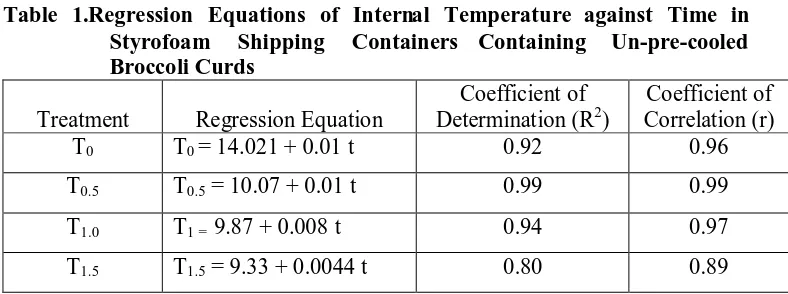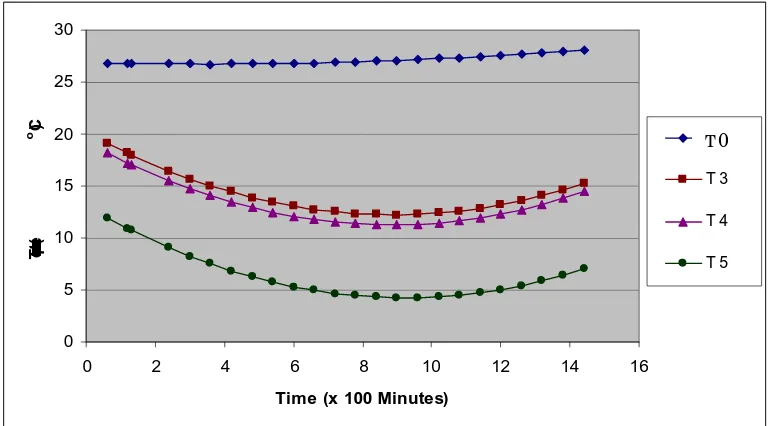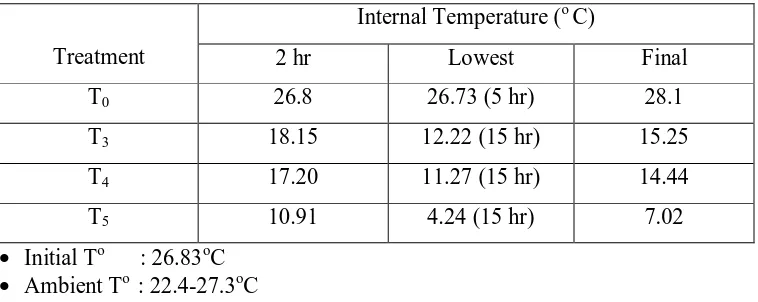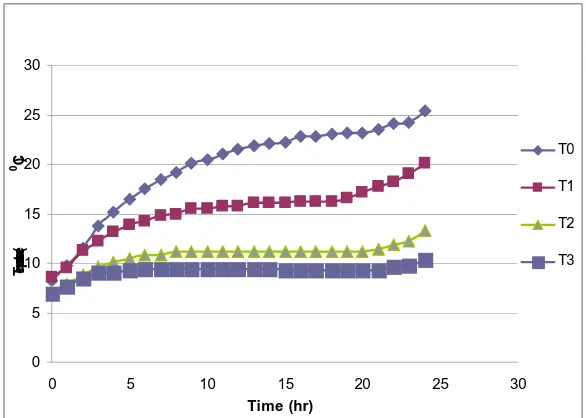Part 1 : Without Precooling Treatment
Part 2 : With Air-cooling Treatment
Part 3 : With Hydro-cooling Treatment
By
Nurpilihan Bafdal
Carmencita Tjahjadi
Seok-In Hong
Dongman Kim
Debby Sumanti Moody
Totok Pujianto
Joint Research Between
The Padjadjaran University
and
The Korea Research Institute
I. Introduction
Post-harvest handling of agriculture produce is of great importance to support successful agricultural production. Introducing proper post-harvest handling technologies may improve quality, appearance, texture, flavor, nutritive value as well as shelf-life of produce and thus improve value added.
The province of West-Java is the major vegetable producing area of Indonesia, supplying vegetables for domestic use as well as export to Asean countries such as Singapore and Malaysia. Vegetables for export should be of superior quality and condition. Mitchell (1992) stated that shelf-life of fruits and vegetables vary depending on the commodity, environmental conditions and packaging method. Broccoli has a very short shelf-life, respectively 1-2 days at 20oC, 60-70 % RH, 2-6 days at 4oC, 80-90 % RH, 1-2 weeks at 0oC, 90-95 % RH and 3-4 weeks at 0oC, 90-95 % RH and packed in a polystyrene box with ice (Tan, 2005).
Post-harvest handling practices in Indonesia are still very minimal. On farm-field handling is done by the farmer and usually consist of sorting marketable and not marketable produce and field-packing (Tjahjadi, 2006). Broccoli curds are then cleaned of leaves, wrapped in newspaper or leaves may sometimes be left on to reduce transportation damage. Finally it is packed in plastic/bamboo baskets or polyethylene bags and shipped to whole markets or packers (Tjahjadi, 2006). For the export markets, exporters then repack the commodity in polystyrene boxes with no cooling at all or sometimes with crushed ice-cooling within the box, and ship them overnight to Jakarta for transportation on the first flight to overseas destinations.
Maintaining high quality and extending shelf-life as long as possible requires broccoli to be kept at 0oC, 90-95 % RH immediately after harvesting and during subsequent post-harvest handling. Indonesian vegetable exporters, however do not posses sophisticated cooling facilities, and besides most of them consider it not economically feasible to use mechanically refrigerated shipping-containers.
pre-cooling vegetables, respectively air pre-cooling, forced air pre-cooling, hydro-pre-cooling, vacuum cooling, evaporative cooling and contact ice cooling. For broccoli hydro-cooling followed by contact ice hydro-cooling with crushed ice is the best solution (Ryall and Lipton, 1972). According to Tan (2005), this method is suitable for both local markets as well as export by air freight.
For Indonesian farmers and vegetable exporters the most feasible and practical method of cooling is by contact ice cooling with crushed ice, because ice is readily available everywhere and the distance from the vegetable production centers (such as Bandung) to Jakarta is only about 2.5 hours by truck, while to reach Singapore by air from Jakarta takes about 1.5 hours. So far however, no data are available how much crushed ice is needed to maintain sufficiently low temperatures within styrofoam shipping container for broccoli export.
The Faculty of Agriculture Industrial Technology, Padjadjaran University and The Korea Food Research Institute I (KFRI), through The Korea Indonesia Technology Centre (KITECH) have started joint research on “Development of Post-Harvest Field Technology of Fresh Exportable Vegetables Produced in Indonesia” since the year 2006. The objective of this experiment, which is part of the second year research activity within this program, was to determine the best ratio of broccoli to crushed ice in a standard size styrofoam box (52 cm x 37 cm x 30 cm ; 2.5 cm thickness) filled with 5 kg of broccoli (about 20 curds of broccoli).
II. Material and Methods
Time and Location of Research
The experiment was carried out at the Food Process Engineering and the Post-harvest Technology Laboratories of the Faculty of Agriculture Industrial Technology of The Padjadjaran University, at Jatinangor-West Java, on August 6-9, 2007 for part 1 and 2, and August 25 – 26, 2007 for part 3.
Materials :
Broccoli (Brassica oleracea L. gp. Italica) of the cultivar Luky (Bejo) harvested two months after planting and processing curds of about 15 cm diameter, dark green in color and compact was used for the experiment. The shipping package was styrofoam boxes (52 cm x 37 cm x 30 cm ; 2.5 cm thickness). Other materials employed were crushed ice, taping film, polyethylene bags and newspaper. The equipments used were Ohauss balance, thermometers, sling hygrometer, plastic-bag sealer and a Canon digital camera.
Methods :
A descriptive experimental method in three replications was employed, followed by regression analysis consisting of two variables (Steel & Torrie, 1995 ; Gaspersz, 2000). The experiment consisted of three parts.
Part I. The Effect of Ratios of Un-pre-cooled Broccoli to Crushed Ice on Internal Temperature of the Styrofoam Shipping Containers
Broccoli curds were left to cool down to ambient temperature and were then packed in styrofoam boxes. The treatments were three ratios of broccoli to crushed ice, respectively 5 kg broccoli/0.5 kg crushed ice (T0.5), 5 kg broccoli/1
kg crushed ice (T1), 5 kg broccoli/1.5 kg crushed ice (T1.5) and control (T0 :
Prior to use all thermometers were calibrated: freezing point was -1.5oC, while boiling point was 93o C. therefore temperatures observed were corrected as follows:
T corrected = x
92 150
(T observed – 1.5)
Twenty broccoli curds were put into a styrofoam box with crushed ice in PE bags over-wrapped with new paper at the center (Fig. 1). A calibrated thermometer was inserted into the side of the container. After closing the container, the lid of the styrofoam box was sealed with taping film. Internal temperatures were read at 15 minute intervals for 24 hours; while environmental temperatures and RH were measured every six hours by sling hygrometer. The experimental lay out is presented in Fig. 2.
1. Broccoli curds
2. Packs of crushed ice in PE bags, over-wrapped in newspaper 3. Cellophane tape
4. Thermometer 5. Styrofoam box
Fig1. The Experimental Set-Up in Styrofoam Shipping Container
3
5
4
Fig.2 Experiment Lay-Out
Part 2. The Effect of Ratios of Air-Cooled Broccoli (5oC) to Crushed Ice on Internal Temperature of the Styrofoam Shipping Container
Air-cooling of the broccoli curds was done by storing the curds overnight in cold storage set at 5oC. Preparation and observation of treatments were done as in part 1.
Treatments consisted of three ratios of broccoli to crushed ice, respectively 5 kg broccoli/3 kg crushed ice (T3), 5 kg broccoli/4 kg crushed ice (T4), 5 kg
broccoli/5 kg crushed ice (T5) and control (T0 : 5 kg broccoli without crushed ice).
The objective of this experiment was to keep internal temperature close to 5oC for 24 hours.
Part 3. The Effect of Ratios of Hydro-cooled Broccoli Curds to Crushed Ice on Internal Temperature of the Styrofoam Shipping Containers
excess water. Consequently preparation of samples and observation were carried out as in part 1.
The treatments, however, consisted of the same three ratios of broccoli to crushed ice as in part 2, respectively 5 kg broccoli/3 kg crushed ice (T3), 5 kg
broccoli/2 kg crushed ice (T2), 5 kg broccoli/1 kg crushed ice (T1) and Control (To
: 5 kg broccoli without crushed ice). The objective of this experiment was to keep internal temperatures within the styrofoam box at about 5oC for a period of 24 hours.
III. Results and Discussion
Part I. The Effect of Ratios of Un-pre-cooled Broccoli Curds to Crushed Ice on Internal Temperature of the Styrofoam Shipping Containers
Temperature profiles in the styrofoam shipping containers against time (24 hours) of the 4 treatments are presented in Fig. 3, while the regression equations are shown in Table 1.
Table 1.Regression Equations of Internal Temperature against Time in Styrofoam Shipping Containers Containing Un-pre-cooled Broccoli Curds
Table 1. shows that all regression equations were linier and possess a good fit (R2 ≥ 0.80). Overview of internal temperatures is presented in Table 2.
Table 2. Overview of Internal Temperatures in the Styrofoam Box Containing Un-pre-cooled Broccoli Curds
Internal Temperature (o C)
Treatment 2 hr Lowest Final Domestic refrigerator < 7oC
Indonesia due to economical reasons. Another solution, which will be carried out in part 2 and 3 of this research, is to lower initial temperature of the broccoli curds by using either air-cooling or hydro-cooling.
Part 2. The Effect of Ratios of Air-Cooled (5oC) Broccoli Curds to Crushed Ice on the Internal Temperature of the Styrofoam Shipping Containers
Temperature profiles in the styrofoam shipping containers against time (24 hours) of the four treatments are presented in Fig.4, while the regression equations are shown in Table 3.
0
Fig 4. Temperature Profiles in the Styrofoam Shipping Containers against Time of Air-Cooled (5oC) Broccoli Curds
Table 3 shows that regression equation of all treatment posses good fit (R2≥0.80) except for T4. Overview of internal temperature is presented in Table 4.
Table 4. Overview of Internal Temperatures of Styrofoam Box Containing Air-Cooled Broccoli Curds
Internal Temperature (o C)
Treatment 2 hr Lowest Final
T0 26.8 26.73 (5 hr) 28.1
T3 18.15 12.22 (15 hr) 15.25
T4 17.20 11.27 (15 hr) 14.44
T5 10.91 4.24 (15 hr) 7.02
Initial To : 26.83oC Ambient To : 22.4-27.3oC
The lowest internal temperature for T3, T4 and T5 were respectively
12.220C, 11.27oC and 4.240C, which were all attained at 15 hours after packaging. Normal domestic refrigerators are designed to store food at below 7oC, although some of the shelves may have a temperature of 10oC (Tull, 1987). Accordingly, treatments T3 and T4 were not able to attain normal refrigerator temperature ;
while T5 could.
T5 (5 kg broccoli/5 kg ice) was able to:
a. Reach a temperature of 12oC, 100C and 7oC in 60, 180 and 420 minutes. b. Maintain a temperature of less than 5oC from 660 minute (11 hours) up to
1140 minute ( 19 hours) after packaging,
c. At the end of the experiment it still kept internal temperature at 7oC. During the entire experiment internal temperature of T0 (5 kg broccoli/0 kg ice)
range between 26.8oC up to 28.1 oC; while ambient temperature varied between 22.4oC and 27.3oC.
At the end of the observation period internal temperature of To, T3, T4 and
T5 were respectively 28.1oC, 15.2oC, 14.4oC and 7.0oC. The lower the ratio of
container to 0oC, which is needed for a shelf life of 3-4 weeks, as reported by Tan (2005). The same authors said at 4oC and 80-90 % RH broccoli keeps 2-6 days.
Kasmire and Thompson (1992), reported cooling methods for a small size operation of this vegetable should use forced air cooling, package icing or a combination of both. Considering the results above, the vegetable should preferably be pre-cooled by hydro-cooling to 0oC-5oC and then packed in ice prior to shipping. This is needed to compensate for the very high respiration rate of broccoli i.e. 7450-100000 BTU/ton/24 hr (Potter, 1986). In the US, however, many broccoli packers tend to add more ice to handle refrigerating needs in transport plus an extra 4.5 kg of ice in the box when it arrives at the market (Kasmire and Thompson, 1992).
Part 3. The Effect of Ratios of Hydro-cooled Broccoli Curds to Crushed Ice on the Internal Temperature of the Styrofoam Shipping Containers
Temperature profiles in the styrofoam shipping containers against time (24 hours) of the four treatments are presented in Fig. 5, and their equations in Table 5.
Table 5. Regression Equations of Internal Temperature Profiles against Time in Styrofoam Shipping Containers holding Hydro-cooled Broccoli Curds
Treatment Regression Equation Coefficient of Determination (R2)
Overview of internal temperature is presented in Table 6.
Table 6. Overview of Internal Temperatures of Styrofoam Box Containing Hydro-cooled Broccoli Curds
Internal Temperature (o C)
Treatment 2 hr Lowest Final
As previously mentioned Tull (1987) stated that domestic refrigerators are designed to store food below 7oC, although some of the shelves may have a temperature of 10oC. Accordingly treatment T3 (5 kg broccoli/3 kg crushed ice)
above chilling injury temperatures. Likewise, there might be a possibility to prolong storage life by using the T3 treatments in combination with MAP.
Personal communication (2007) with a broccoli producer at Cisarua confirmed that MAP could keep broccoli curds in better condition than cold storage alone.
V. Conclusion
1. Without pre-cooling, styrofoam shipping containers filled with 5 kg broccoli and 1.5 kg crushed ice was able to keep down internal temperature to 15,6oC at the end of the 24 hour observation.
2. With air-cooling to 5oC, styrofoam shipping containers filled with 5 kg air-cooled broccoli and 5 kg crushed ice was able to lower internal temperature down to 7oC at the end of the 24 hour observation.
15




